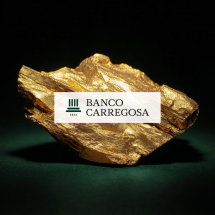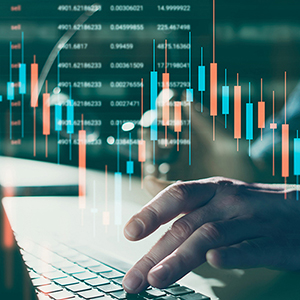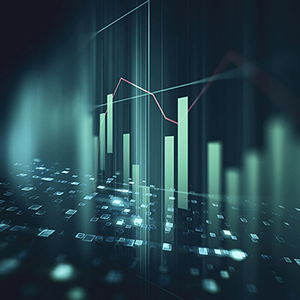- The Bank
- People
- All Services
- Private Banking
- Savings and Investment
- GoBulling Platforms
- Institutional and Corporate
- Insights
- Login My.BancoCarregosa
- Contacts
Enter your Username to gain access to your Bank. Complete your authentication on the next screen.
If you are not yet a client, open your account here or contact us for more information
What to consider when buying gold

Buying gold has been a safeguard for investors for several centuries. But what makes this asset so desirable and what should we take into account when investing in gold?
Gold is a unique asset: it has high liquidity but yet is scarce; it is a luxury as much as an investment. It acts as a diversifier in the face of stock market fluctuations. Buying gold can serve as a hedge against inflation and currency risk.
Find out why buying gold has been a frequent choice among investors for several centuries, in different cultures and in varied market situations.
The advantages of buying gold
From an investor's point of view, there are many advantages to buying gold; in particular that its market value has historically been increasing and that it also helps diversify the investment portfolio in a way that is uncorrelated with the financial markets.
Diversification
Gold is one of the most effective diversifiers, uncorrelated with financial market developments. Historically, gold has had a negative correlation with equities and other financial instruments.
In the 1970s, for example, the price of gold rose as most stocks lost. The opposite happened in the 1980s and 1990s, good for stocks but bad for gold. In 2008, the situation reversed again: stocks fell substantially as investors migrated to gold. It is therefore recommended that investors diversify by combining gold with other securities in their portfolio.
Preservation
Gold has remained important over time as a way of transmitting and preserving wealth from one generation to the next. Since ancient times, different cultures have valued the unique properties of this precious metal. Gold does not corrode, is easy to work with and has a unique colour. But its value does not derive only from its aesthetics. This asset continues to be sought after by the real economy, in areas such as technology, automotive industry and telecommunications.
Protection against currency devaluation
The US dollar is one of the world's most important reserve currencies. However, when its value falls against other currencies, as it did between 1998 and 2008, many people seek the safety of gold, which drives up the price thereof. The price of gold almost tripled between 1998 and 2008, reaching the $1,000 per ounce mark in early 2008 and almost doubling between 2008 and 2012 to reach $2,000.
GOLD PRICE EVOLUTION IN $ PER OUNCE

Source: Goldprice
Protection against inflation and deflation
Gold has historically been an excellent hedge against inflation, because the price tends to rise as the cost of living increases. When a currency loses purchasing power due to inflation, the price of gold tends to rise with that of other assets, and the investor is thus protected. For this reason, gold is seen as a good store of value, an option when currencies lose value.
On the other hand, buying gold also protects the investor against the opposite phenomenon, deflation. This term defines a period when prices fall and business activity slows down, often accompanied by excessive public debt. During the Great Depression in the US, for example, the relative purchasing power of gold soared, while many other prices fell. In a situation like this, people choose to save money rather than spend it, and to do so they choose to buy gold, which drives up the price.
Geopolitical uncertainty
Prices usually increase the most when trust in governments is low. When world tensions rise, there is a tendency to buy gold and the price rises. During these periods, the performance of this asset is greater than that of other investments.
Supply constraints
As a general rule, reduction in gold supply increases prices. Much of the gold supply on the market since the 1990s has come from sales of gold bars from the vaults of the world's central banks, which has greatly decreased since 2008. At the same time, gold extraction from mines has been stabilising since the 2000s.
ANNUAL GOLD EXTRACTION IN TONS (2020)

Source: BBC
Increased demand
In recent years, the growth of some emerging markets with a large appetite for gold has been driving demand. In these countries, buying gold is a cultural stance associated with high status in society. In China, for example, gold bars are a traditional form of savings, and demand has been growing at a steady pace. India is the second largest gold-consuming nation in the world. The wedding season in this country, which takes place in October, is traditionally the time of year with the highest global demand for gold.
How to buy gold: from bars to ETFs
There are several ways to get exposure to Gold.
At Banco Carregosa we offer several forms of exposure to this precious metal: Gold Bars, Investment Funds or ETF (Exchange Traded Funds).
Gold Bars. We ensure the purchase, sale, safekeeping and withdrawal of C-Hafner Gold Bars, the oldest family refiner in Germany. These are bars with the highest purity grade on the market, 999.9, packed in a sealed casing featuring a unique serial number.
Investment funds. Depending on the Fund manager's strategy, you may have access to securities from the gold 'universe', such as mining companies or companies related to other precious metals. In this way, you gain exposure to gold and can also maintain a recurring income from dividends that the fund may pay out.
Gold acts as a safe haven value in times of financial uncertainty. In today’s economy, buying gold is again an option for investors seeking to protect their assets from the challenges of financial markets and for private individuals seeking to acquire a universal and timeless value.
ETFs and Other Forms of Exposure. Similar to Mutual Funds, ETFs allow for diversification of exposure and are listed and traded on an exchange. As an example, the SPDR Gold Trust has become one of the largest ETFs in the US as well as the largest holder of gold bullion in the world in 2019. Find out what ETFs are and how they work.
Click here for additional Legal Information.



















